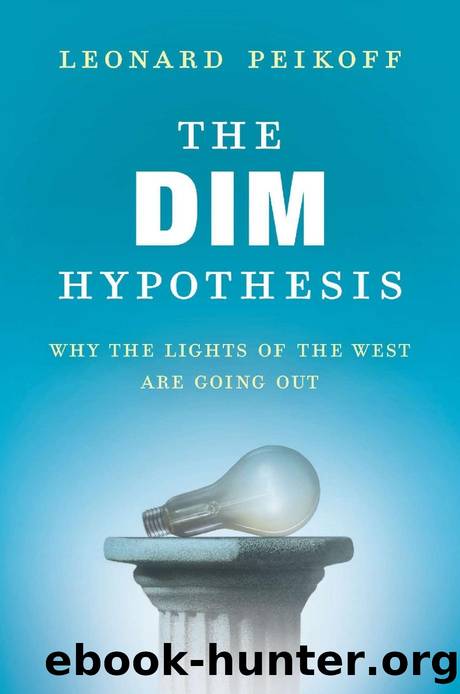The DIM Hypothesis by Leonard Peikoff

Author:Leonard Peikoff [Peikoff, Leonard]
Language: eng
Format: epub
ISBN: 9781101617366
Publisher: Penguin Publishing Group
Published: 2012-09-04T05:00:00+00:00
Science
Science, like drama, started in Greece. From the sixth century B.C. through the Hellenistic era, an unprecedented approach to gaining knowledge of Nature was developed by many illustrious figures. Among the better known are Thales, Euclid, Hippocrates, Archimedes, and Aristarchus. Their method of gaining knowledge of the physical world was the same: observation of facts, then the use of man’s rational faculty to reach a secular interpretation of them.
Thales, who started the whole enterprise, began with sense experience—water, he noted, can assume all three forms of matter, liquid, solid, and gas; in river deltas, it turns into earth; in evaporation, into air; and it is essential to life. From such observations he drew a secular and in his case universal conclusion. Centuries later, when considering a disease that the Mesopotamians had attributed to displeased gods, Hippocrates was using the same method. “I am about to discuss the disease called ‘sacred,’” he writes. “It is not, in my opinion, any more divine or more sacred than other diseases, but has a natural cause, and its supposed divine origin is due to men’s inexperience….” It is not enough, he writes elsewhere, simply to make up theories:“…one must attend in medical practice not primarily to plausible theories, but to experience combined with reason…. I approve of theorising also if it lays its foundation in incident, and deduces its conclusions in accordance with phenomena.”170
Most of the Greek scientists were too early or their interests too narrow to seek an overall system of physics. The only thinkers to attempt such a task were Plato, Democritus, and Aristotle. The first two, however, being rationalists, were not representative of the long line of Greece’s scientific pioneers. That is why it is Aristotle who is still called the father of science.
Since we already know Aristotle’s underlying epistemology, I turn now to Aristotle the practicing scientist. He identifies physics as the study of Nature and more specifically of moving objects. He observes six types of motion: substantive change, coming to be, passing away, quantitative change, qualitative change, and change of place or locomotion. In pursuing this study, Aristotle takes, as his paradigms of change, living action and distinctively human action—for example, an acorn becoming an oak, or an educator teaching a lesson. He chooses such examples deliberately, rejecting the idea that all motion is reducible to locomotion. He is seeking to reach a theory of motion that will apply to all types of motion. A theory derived only from its simplest form, locomotion, will leave the more complex types unexplained; whereas a theory that explains the complex will have no difficulty in explaining the simple as well.
Aristotle begins his study with a generalization he regards as based on a great wealth and variety of observations: that the course and outcome of any given natural process is consistent—i.e., that the process continually takes place in the same way. The acorn regularly grows into an oak, not a bunch of daffodils; the teacher transfers his knowledge to his students, rather than
Download
This site does not store any files on its server. We only index and link to content provided by other sites. Please contact the content providers to delete copyright contents if any and email us, we'll remove relevant links or contents immediately.
The remains of the day by Kazuo Ishiguro(7551)
Tools of Titans by Timothy Ferriss(6946)
The Black Swan by Nassim Nicholas Taleb(6190)
Inner Engineering: A Yogi's Guide to Joy by Sadhguru(5895)
Giovanni's Room by James Baldwin(5878)
The Way of Zen by Alan W. Watts(5799)
The Six Wives Of Henry VIII (WOMEN IN HISTORY) by Fraser Antonia(4790)
The Power of Now: A Guide to Spiritual Enlightenment by Eckhart Tolle(4755)
Astrophysics for People in a Hurry by Neil DeGrasse Tyson(4620)
Asking the Right Questions: A Guide to Critical Thinking by M. Neil Browne & Stuart M. Keeley(4574)
12 Rules for Life by Jordan B. Peterson(3734)
The Ethical Slut by Janet W. Hardy(3502)
Skin in the Game by Nassim Nicholas Taleb(3460)
Housekeeping by Marilynne Robinson(3401)
The Art of Happiness by The Dalai Lama(3383)
Double Down (Diary of a Wimpy Kid Book 11) by Jeff Kinney(3272)
Skin in the Game: Hidden Asymmetries in Daily Life by Nassim Nicholas Taleb(3264)
Walking by Henry David Thoreau(3234)
12 Rules for Life: An Antidote to Chaos by Jordan B. Peterson(3200)
